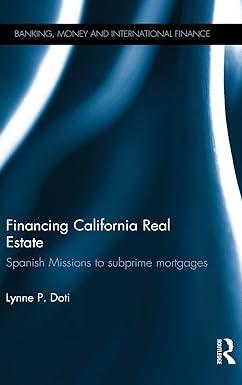Question
1. In the CAPM, the most efficient way to take a lot of risk is to Buy a well-balanced portfolio of the riskiest stocks in
1. In the CAPM, the most efficient way to take a lot of risk is to
Buy a well-balanced portfolio of the riskiest stocks in the market
Buy risky stocks that are also undervalued
Borrow money and buy a well-diversified portfolio
Explain
2. The correct risk-free rate to use in the CAPM
Is the short-term default-free rate
Is the long-term default-free rate.
Can be either, depending on whether the prediction is short term or long term.
Explain
3. Assume that stocks are the only risky assets and that you are offered two investment options:
A riskless investment on which you can make 4%.
A mutual fund of all stocks, on which the returns are uncertain.
How much of an expected return would you demand to shift your money from the riskless asset to the mutual fund?
Less than 4%
Between 4% and 6%
Between 6% and 8%
Between 8% and 10%
Between 10% and 12%
More than 12%
4. Assume that you are comparing a European automobile-manufacturing firm with a U.S. automobile firm. European firms are generally much more constrained in terms of laying off employees, in the face of an economic downturn. What implications does this have for betas, if they are estimated relative to a common index?
The European firm will have much a higher beta than the U.S. firms.
The European firm will have a similar beta to the U.S. firm.
The European firm will have a much lower beta than the U.S. firms.
Explain
5. In the two projects in Figure 5.4, page 205, the NPV decreased as the discount rate was increased. Is this always the case?
Yes or No
If no, when might the NPV go up as the discount rate is increased?
6. If the earnings for a firm are positive, the cash flows will also be positive.
True or False
Why or why not?
7. In the analysis, we assumed that Bookscape (Illustration 5.4 page 174 & 5) would have to maintain additional inventory for its online book service. If, instead, we had assumed that Bookscape could use its existing inventory (i.e., from its regular bookstore), what will happen to the cash flows on the project?
Cash flows will increase.
Cash flows will decrease.
Cash flows will remain unchanged.
Explain
8. Which of the following would be your best combination of projects given your capital rationing constraint of $100,000?
| Project | Initial Investment (in 1,000s) ($) | NPV (1,000s) ($) |
| A | 25 | 10 |
| B | 40 | 20 |
| C | 5 | 5 |
| D | 100 | 25 |
| E | 50 | 15 |
| F | 70 | 20 |
| G | 35 | 20 |
B,C,and G
A,B,C,and G
A,B,and G
Other
Explain
Step by Step Solution
There are 3 Steps involved in it
Step: 1

Get Instant Access to Expert-Tailored Solutions
See step-by-step solutions with expert insights and AI powered tools for academic success
Step: 2

Step: 3

Ace Your Homework with AI
Get the answers you need in no time with our AI-driven, step-by-step assistance
Get Started


